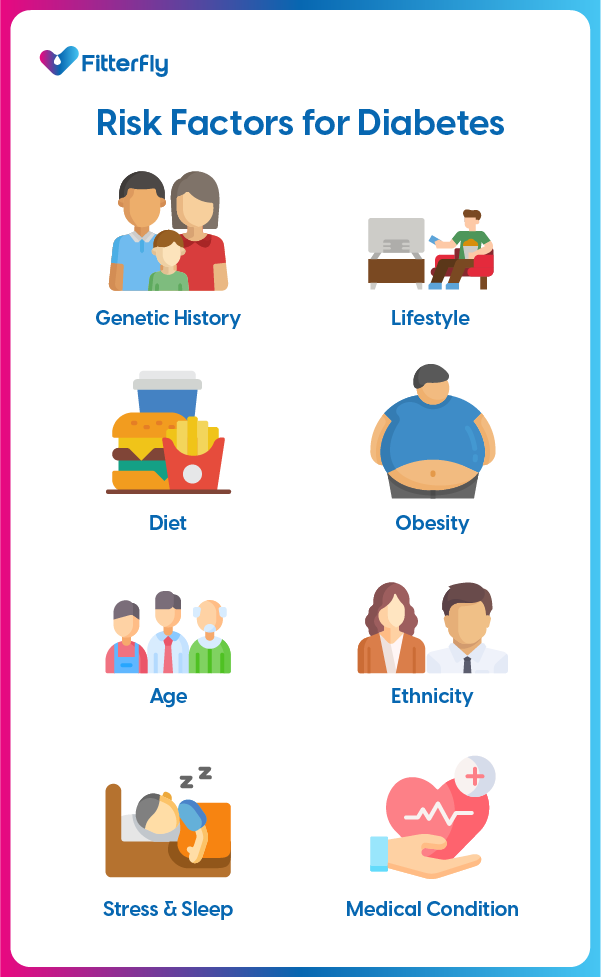What are the Key Risk Factors for Diabetes and How to Counter Them?

What are the Risk Factors for Type 2 Diabetes?
Diabetes is an epidemic that’s silently destroying millions of lives worldwide. It’s time to take action and raise awareness about this devastating disease.
Together, we can make a difference and help prevent further damage. But what if I told you that there are certain hidden diabetes risk factors lurking within our daily routines and habits? It’s time to shed light on these silent culprits and take charge of our health.
In this eye-opening article, we will tell you in detail about the lesser-known risk factors for Diabetes that often go unnoticed. From sedentary lifestyles to excessive stress, poor sleep habits, and nutrition choices, we uncover the connections between these factors and the development of this chronic condition.
By understanding the diabetes risk factors, we can make informed choices and proactively prevent the onset of Diabetes.
1. Genetic Risk Factors for Diabetes
- Although lifestyle changes can lower the risk of Diabetes, genetic factors also play a vital role in determining a person’s susceptibility to the disease. Studies suggest that some genes can increase the likelihood of developing diabetes, particularly type 2 diabetes. One of the main genetic diabetes risk factors is a family history of the disease.
- If one or both of your parents have Diabetes, your risk of developing the condition is significantly higher. However, it’s important to note that having a family history of Diabetes doesn’t guarantee that you will develop the disease. It simply means you have an increased risk compared to someone with no family history.
- Genetic risk factors for Type 2 Diabetes include genetic variants affecting insulin production and the body’s ability to regulate blood sugar levels. It’s important to remember that Diabetes can be caused by inherited gene variants from one or both parents.
- However, it’s essential to remember that genetics is just one factor in the development of diseases. Healthy habits and lifestyle choices are also significant factors to consider.
2. Lifestyle Risk Factors for Diabetes
Although genetics can increase the chances of an individual getting Diabetes, it is not the only factor. The lifestyle choices that people make also have a significant impact on the development of the disease. Studies indicate that up to 90% of type 2 diabetes cases can be attributed to modifiable lifestyle factors.
Did you know that leading a sedentary lifestyle is one of the most significant lifestyle risk factors for Type 2 Diabetes? It’s true! So, let’s get moving and ensure we care for our health.
- With the increasing use of technology and desk jobs, people are spending more and more time sitting down. This type of lifestyle can contribute to weight gain, insulin resistance, and, ultimately, the development of Diabetes.
- Physical activity reduces diabetes risk. Make it a daily priority to overcome barriers and prevent Diabetes.
- Excessive stress is another lifestyle factor that can contribute to the development of Diabetes. During difficult times, our bodies release cortisol, increasing blood sugar levels.
- If this happens too often, it can lead to chronic high blood sugar levels, which can increase our risk of developing Diabetes. That’s why managing stress in healthy ways, like exercising, practising relaxation techniques, and leaning on loved ones for support, is so important.
- Getting enough restful sleep is also crucial to reducing the risk of Diabetes. When we don’t get enough sleep, it can make our bodies more resistant to insulin and lead to weight gain.
- Make a consistent sleep schedule and create a calming bedtime routine for good sleep hygiene. By doing these simple things, we can help reduce our risk of developing Diabetes and maintain good overall health.
At Fitterfly, lifestyle modifications should be the first line of therapy for managing Diabetes. This is especially true when one is in the Prediabetes stage when the chances of reversal are maximum.
That’s why our Diabetes Prime Program is designed so that one can control or even through correct nutrition intervention, fitness assessments, and sleep & stress management.
To know your chances of Diabetes reversal, take the Diabetes Reversal TestDiabetes Reversal
Calculator
3. Dietary Risk Factors for Type 2 Diabetes
- The food we eat is very important for our health and can affect our chances of getting Diabetes. Eating a lot of processed food, sugary drinks, and unhealthy fats can make it more likely to get Diabetes.
- These foods usually have a lot of calories but not many nutrients, which can lead to weight gain and problems with insulin.
- Eating fruits, vegetables, whole grains, and lean proteins can help lower the risk of Diabetes. These foods are full of important nutrients, vitamins, and minerals that keep us healthy and help control blood sugar levels. Adding these healthy foods to your diet can help prevent diabetes.
- In addition to the types of foods we consume, portion control is crucial in managing diabetes risk. Eating too much and having larger portions can make you gain weight and put you at risk for Diabetes.
To stay healthy and avoid this, try to pay attention to your hunger and fullness signals and keep an eye on how much you eat. This will help you maintain a healthy weight and reduce your chances of developing Diabetes.

4. Sedentary Lifestyle and Its Impact on Diabetes Risk
- A sedentary lifestyle, characterized by long periods of sitting or inactivity, has been identified as a significant risk factor for Diabetes. When we lead a sedentary lifestyle, our bodies burn fewer calories, leading to weight gain and an increased risk of insulin resistance.
- Sedentary behavior can take many forms, from sitting at a desk for long hours to spending leisure time in front of screens. These activities reduce physical activity and increase the likelihood of consuming unhealthy snacks or meals while being sedentary.
- It’s important to include exercise in our daily lives to fight the negative effects of sitting too much. This can be as easy as taking short breaks to stretch and walk when sitting for a long time.
- Doing things like walking, biking, swimming, or joining group exercise classes can also help us be more active and lower the risk of getting Diabetes.
5. Obesity and Its Correlation with Diabetes
- Being overweight or obese is a known risk for Diabetes, especially type 2 diabetes. When we are too heavy, our bodies don’t respond as well to insulin, which causes higher blood sugar levels and a greater chance of getting Diabetes.
- Having too much body weight, especially around the belly, can cause long-term inflammation and make the body less sensitive to insulin. This inflammation makes it harder for the body to control blood sugar levels, which raises the risk of Diabetes.
- To lower this risk, it’s important to keep a healthy weight. This can be done by exercising regularly and eating a balanced diet.
- Activities that help lose weight, like strength training and cardio exercises, can decrease body fat and improve the body’s insulin use.
6. Age and Diabetes Risk
- Age is another risk factor for Type 2 Diabetes, with the risk increasing as we get older. This is primarily due to the natural decline in insulin sensitivity with age.
- As we age, our bodies become less efficient at using insulin to regulate blood sugar levels. This can lead to insulin resistance and an increased risk of developing Diabetes.
- Additionally, age-related changes in body composition, such as increased fat mass and decreased muscle mass, can further contribute to the development of Diabetes.
- Although we can’t stop getting older, we can do things to lower our chances of getting Diabetes as we age. This means living a healthy life, keeping a healthy weight, and often checking our blood sugar levels with doctors’ visits.
7. Ethnicity and Diabetes Risk
- Certain ethnic groups have a higher prevalence of Diabetes compared to others. This suggests that ethnicity plays a role in Diabetes risk, although the exact mechanisms are not fully understood.
- For example, individuals of South Asian (which includes Indians), Hispanic, African, and Native American descent have been found to have a higher risk of Diabetes compared to Caucasians. Genetic factors, lifestyle choices, cultural dietary preferences, and social determinants of health may influence this increased risk.
- Understanding the increased risk associated with specific ethnicities can help individuals and healthcare professionals tailor prevention and management strategies accordingly. It highlights the importance of culturally sensitive healthcare and the need for targeted interventions to reduce the burden of Diabetes within these communities.
8. Medical Conditions That Increase the Risk of Diabetes
- Some health problems can make it more likely to get Diabetes. For instance, women with polycystic ovary syndrome (PCOS) are at a higher risk of becoming resistant to insulin and getting type 2 diabetes.
- PCOS is a condition that affects women who can have babies. It causes irregular periods, too much hair growth, and cysts on the ovaries.
- Other medical conditions that can increase the risk of Diabetes include high blood pressure (hypertension) and high cholesterol (dyslipidemia).
- Did you know that certain conditions like high blood pressure and high cholesterol often go hand in hand with Diabetes? The good news is that managing these conditions through lifestyle changes, regular monitoring, and medical interventions can help reduce the risk of developing Diabetes.
- Working closely with your healthcare provider to develop a treatment plan that works for you is essential.
FitterTake
Diabetes is a complex condition with various risk factors, both genetic and lifestyle-related. While some diabetes risk factors, such as genetics and age, cannot be changed, there are many modifiable factors that we can control to reduce the risk of developing Diabetes.
Are you ready to make a positive change in your life? Adopting a healthy lifestyle, including regular physical activity, is one of the best steps you can take. It’s not just about looking good; it’s about feeling great, boosting your mood, and increasing your energy levels.
At Fitterfly, we understand the importance of a personalized approach to health and fitness. Our expertise in diabetes management allows us to create a plan that’s tailored to your unique health profile, meeting your specific needs and goals. Our team of experts is here to guide you through every step of the journey.
With a balanced diet, effective stress management techniques, and adequate sleep, we can significantly lower the risk of developing diabetes. We also consider factors like genetic predispositions, ethnic influences, and existing medical conditions to create a comprehensive and proactive plan for diabetes prevention and management.
With Fitterfly, you’re not just starting a fitness routine; you’re embarking on a journey towards a healthier, happier life with the best support for managing or preventing diabetes. Let’s work together to create a healthier you!
To learn more about how we can help you better manage your diabetes, sign up for the Fitterfly Diabetes Prime Program today! You can also give us a missed call at 08068507599, and we will reach out to you.
Remember, knowledge is power. By understanding the risk factors for Diabetes and making informed choices, we can empower ourselves to lead healthier lives and keep Diabetes at bay. Let’s prioritize our well-being and make positive changes today for a healthier tomorrow.
Reduced diabetes medications in 3 months


6.8%
Happy members
EMI
Guarantee
4.8/5
Diabetes Prime Program
This blog provides general information for educational and informational purposes only and shouldn't be seen as professional advice.
Frequently Asked Questions
What are the main risk factors for Diabetes?
The most significant risks for Diabetes include being overweight, not exercising much, overeating sugar and unhealthy food, getting older (especially after 45 years old), and having family members with Diabetes. For some types of Diabetes, things like your race or having Diabetes when you were pregnant can also increase your risk.
Can Diabetes be hereditary?
Yes, Diabetes can run in families. If your parents, brothers, others, or sisters have Diabetes, you might have a higher chance of getting it, too.
How does lifestyle contribute to the risk of Diabetes?
Your daily habits can affect your risk of getting Diabetes. Eating lots of sugary and unhealthy foods, not moving around much, and being overweight can increase your risk.
What role does age play in diabetes risk?
As you get older, your risk of getting Diabetes, especially Type 2, goes up. This is common after age 45, but nowadays, younger people can get it too because of their poor lifestyle.
Can stress be a risk factor for Diabetes?
Yes, being stressed a lot can play a role. When you're stressed, your body's sugar levels can get messed up, which might increase your risk of Diabetes.
Can Diabetes be prevented?
You can lower your risk by eating healthy, exercising regularly, keeping a healthy weight, and going to the doctor for check-ups. These steps don't guarantee you won't get Diabetes, but they can help a lot.
Are there environmental factors that contribute to Diabetes risk?
Environmental factors like air pollution, chemical exposures, urban lifestyles, work stress, socioeconomic status, and climate change can all increase the risk of developing diabetes.
How often should I get screened for Diabetes if I have risk factors?
If you're at risk, it's a good idea to start getting tested for Diabetes by the time you're 35 years old. You might need to get tested every 1 to 3 years, but your doctor will tell you exactly how often based on your situation.




















